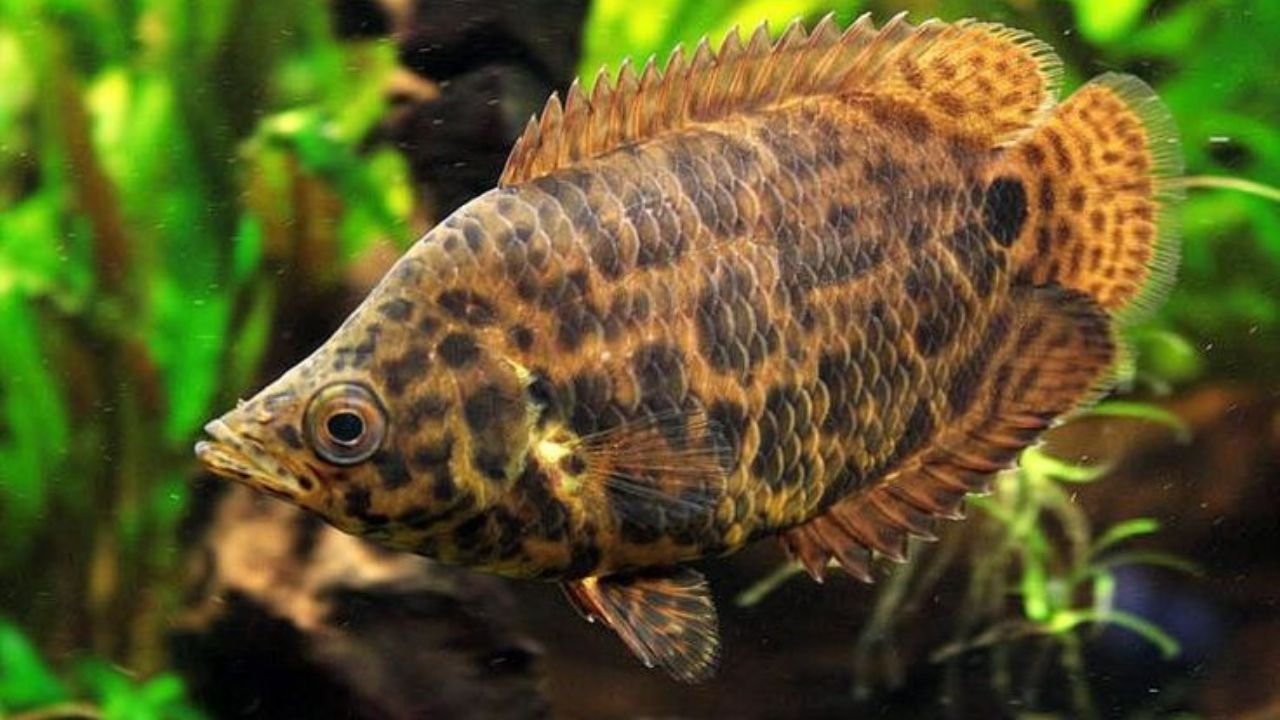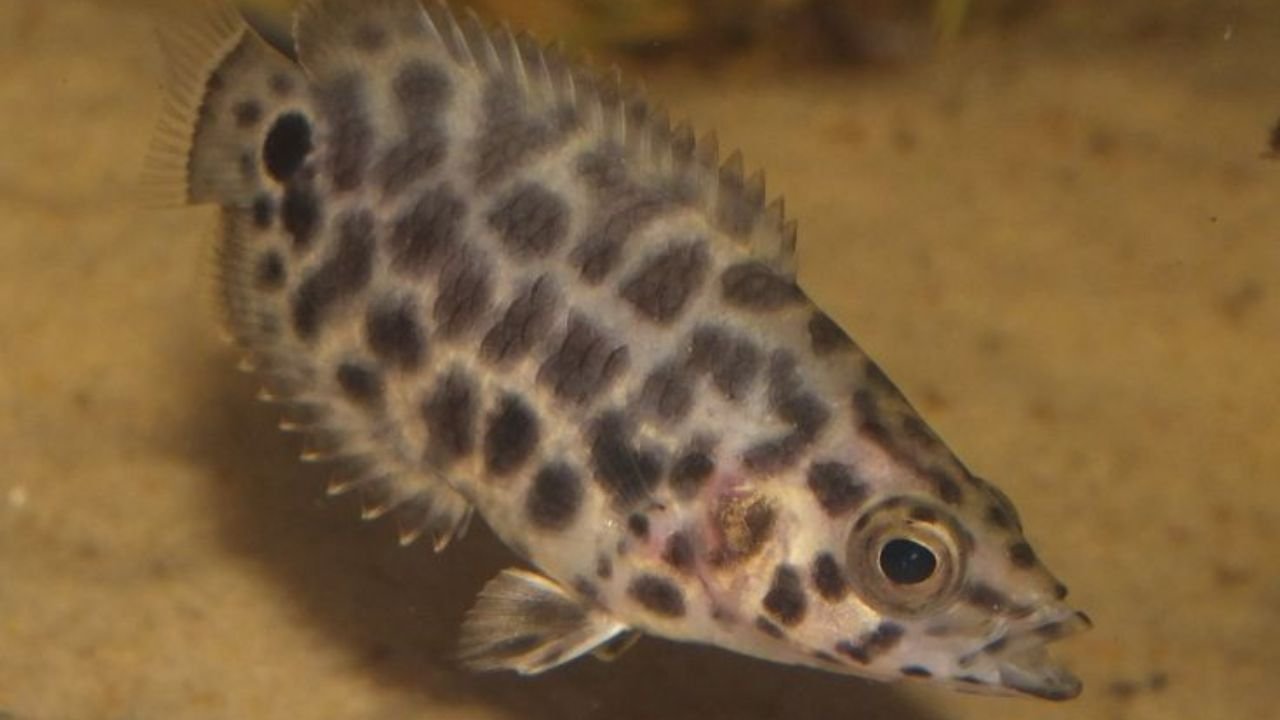Leopard Ctenopoma - Leopard Bush Fish
The Leopard Ctenopoma is a pretty fish with spots. It is also called the Leopard Bush Fish. This fish lives in slow rivers in Central Africa. It eats small fish and moves slowly. People like it because it looks cool and can live well in tanks. In this guide, you will learn how to care for it. We’ll talk about food, tank size, and how it acts. This guide works for new fish keepers and pros too.
Habits of Leopard Ctenopoma
Leopard Ctenopomas are shy and calm. They move slowly and like to hide behind plants or rocks. These fish hunt by surprise. They stay still and wait for small fish to swim close. Then they strike fast. They are most active at night or when the light is low.
- Aquarium Moss
- Coral Beauty Angelfish
- Zebra Danios Care
- Aquarium Filter
- Swordtail Fish
- Planted Aquarium Lighting
Habit | What It Means |
Social Behavior | May chase small or same-size fish |
Activity | Likes the dark; sleeps during the day |
Swimming Level | Swims near the top or middle of the tank |
Personality | Smart and shy; likes places to hide |
Over time, they may know their owner. Some swim up to the glass at feeding time. Do not keep them with tiny fish—they might eat them.

Tank Size
Leopard Bush Fish can grow up to 6 inches in captivity, so they require a decently sized tank to thrive.
Tank Feature | Recommendation |
Minimum Tank Size | 30 gallons for one adult |
Group Size | Can be kept solo or in groups of 3+ (larger tank needed) |
Decor | Dense vegetation, driftwood, caves for hiding |
Substrate | Sand or fine gravel |
Tank Lid | Required – they can jump |
A single Leopard Ctenopoma will do well in a 30-gallon tank, but if you’re planning to keep a small group, consider a 55-gallon or larger aquarium. More space helps reduce territorial aggression.
Water Parameters
These fish thrive in stable, warm water conditions. Regular water changes and filtration are essential for their health.
Parameter | Ideal Range |
Temperature | 75°F to 82°F (24°C to 28°C) |
pH Level | 6.0 to 7.5 |
Water Hardness | 5 – 20 dGH |
Ammonia/Nitrite | 0 ppm |
Nitrate | <40 ppm |
Maintain soft to moderately hard water. Filtration should be gentle to mimic their natural habitat of calm, slow-moving streams. Avoid strong currents, and always use a heater to stabilize temperatures.
Feeding Leopard Ctenopoma
Being carnivorous, Leopard Ctenopomas prefer a protein-rich diet. In the wild, they feed on insects, small crustaceans, and even tiny fish.
Food Type | Notes |
Live Foods | Bloodworms, brine shrimp, guppies (occasionally) |
Frozen Foods | Mysis shrimp, krill, chopped fish |
Pellets | High-protein sinking carnivore pellets |
Feeding Frequency | 1–2 times a day in small portions |
They can be picky eaters when first introduced, often refusing dry foods. Over time, they may accept high-quality pellets, but live or frozen foods remain their favorites.

Breeding Leopard Ctenopoma
Breeding these fish in captivity is possible but requires a dedicated setup. They are egg scatterers, and parental care is minimal or non-existent.
Breeding Aspect | Detail |
Breeding Tank Size | 20–30 gallons |
Water Conditions | Slightly warmer (82°F), soft, acidic water |
Spawning Behavior | Male chases female, scattering eggs among plants |
Fry Care | Remove adults post-spawning to prevent egg-eating |
Fry Diet | Infusoria or liquid fry food initially, then baby brine shrimp |
Use a separate breeding tank with dense floating plants or spawning mops. After laying eggs, it’s best to remove the parents to avoid predation. Eggs typically hatch within 2–3 days.

Quick Summary Table
Here’s a final overview of the care needs of the Leopard Ctenopoma:
Feature | Summary |
Size | Up to 6 inches |
Tank Size | Minimum 30 gallons |
Temperament | Semi-aggressive, predatory |
Diet | Carnivore – live/frozen foods |
Water Temp | 75–82°F |
pH Range | 6.0–7.5 |
Breeding | Egg scatterer, no parental care |
Lifespan | 8–10 years in captivity |
Tips for Success
- Use a dim light setup or floating plants to mimic their natural environment.
- Test water weekly to ensure consistent parameters.
- Do not overfeed—this can lead to water quality issues.
- Avoid small fish like neon tetras or guppies—they may get eaten.
- Provide vertical space—they enjoy swimming upward.
Final Thoughts
The Leopard Ctenopoma is a unique and rewarding fish for hobbyists who enjoy exotic, somewhat mysterious aquarium pets. With their stunning leopard-like spots and ambush hunting style, they’re a captivating addition to semi-aggressive tanks.
While not ideal for community aquariums filled with small fish, they do well in species-only tanks or with robust tankmates. With proper care, you can enjoy their presence for up to a decade.
So if you’re up for the challenge and love observing intriguing fish behavior, the Leopard Bush Fish might be the perfect choice for your aquarium.
FAQs
Are Leopard Ctenopomas aggressive?
Sometimes. They are not mean like some fish, but they can be bossy. They might fight for space. They may also eat small fish. Keep them with fish of the same size.
How big do Leopard Ctenopomas get?
They grow up to 6 inches (15 cm) long in tanks. In the wild, they may get a little bigger. Give them good food and a big tank to help them grow.
How fast do Leopard Bush Fish grow?
They grow pretty fast when they are young, about 1–1.5 inches each month. They grow slower when they get older. Good food helps them grow strong.
How many fish bring luck in an aquarium?
In Feng Shui, 8 fish are lucky. Some people add 8 colorful fish and 1 black fish for extra good luck.
How many Leopard Bush Fish should live together?
Most people keep just one. You can keep 3 or more if the tank is big (55+ gallons) and has many hiding spots. It is not good to keep only two because they might fight.

